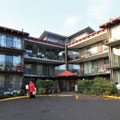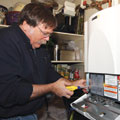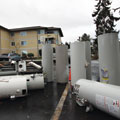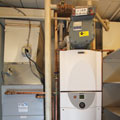
A well-intended retrofit project on a Seattle-area multifamily complex ended up creating a domino effect of sorts.
The Newporter apartments in the Seattle suburb of Bellevue (situated across Lake Washington) was granted federal stimulus money last year for a variety of improvements, including new insulation, siding and window weatherization to its buildings.
“It’s an interesting sequence of events,” notesDan Gilbert, CEO of BlueRidge Company.com, a design manufacturing distribution group based out of Vashon, Wash. (the largest island in Puget Sound).
“I was contacted by a fellow at the housing authority and they wanted me to come out and have a look. They had this funding to re-insulate, weatherize and re-side a mid-’60s three-unit complex, but when they did the remodeling, it triggered another problem with combustion air. All of their aspirating appliances were working off free air. Now they needed an appliance to draw combustion air from the outside and exhaust to the outside.”
This new dilemma caused by the structural improvements turned out to be a blessing in disguise.
“It was not a particularly energy-efficient building,” says Ecotope Principal EngineerJon Heller, P.E., LEED AP. “It was not well-insulated. They had natural draft appliances and there were a lot of cracks in the building. They needed to go with something that was sealed-combustion. They had a water heater, a furnace and a somewhat compromised gas-piping arrangement.”
Gilbert uses the word “sieve” when describing how he first found the building.
“As with many of the buildings that were built prior to the much keener energy-awareness standards, these buildings relied on the leaks, drafts and cracks for infiltration of combustion air,” he says.

The Solution
Heller’s company, Ecotope, specializes in energy efficiency research and consulting and engineering design work for residential and commercial buildings. They wrote the design-build spec for the King County Housing Authority and assisted the contractor in understanding the housing authority’s expectations. He notes there were initial concerns about gas supply, water supply and space constraints in mechanical areas. Heller audited and recommended systems and offered options on mechanical technology to solve concerns, which soon included more insight into inadequate combustion air.“It’s somewhat unusual in Seattle to use individual gas water heaters and furnaces in each apartment in a multifamily building,” he states. “Electric heat and hot water are a lot more common here in this area. Electricity has historically been very cheap here because of the hydroelectric power from the Columbia River.”
The solution to the Newporter’s headache was to remove the existing appliances from each of the 120 1 1/2-bath units in the complex and replace them with a single Laars Mascot II wall-hung boiler and a custom-made Northland air handler.
“They had 6-inch fire vents to slide straight down from the roofing system and drop down into the apartments all in stacks,” Gilbert states. “We pulled out the forced-air furnace and pulled out the water heater and the exhaust vent and dropped two 2-inch PVC pipes in the sleeve, one for the exhaust air and one for the combustion air. We put in an oversized air handler to run at low temperatures and fan speed. We were able to get high-efficiency appliances in the units.”
The combustion air situation became a chief concern, Heller notes, once building envelope repairs were completed.
“They didn’t have the option of leaving in the existing natural-draft appliances,” he states. “They replaced all the windows that caused combustion air problems and might have caused CO2 problems. There was not enough air for the combustion. It would probably be dumping into the units. Whenever you turn on the exhaust fan it would be pulling down the stack.”
Another option discussed was the use of instantaneous water heaters with sidebar fan coil units.
“When Dan Gilbert was consulted, he was able to provide a better, more robust solution with the wall-hung units with internal heat exchangers for domestic water and fan coils for space,” Heller says. “The solution they offered also was very price-competitive. The mechanical system solution worked well.”
Heller adds these types of combustion concerns are commonplace, especially among multifamily units.
“It’s not uncommon to see these challenges with building renovations, but we even encounter them occasionally with new construction,” he states. “Of course, atmospheric combustion is something we now recommend against, and fortunately the industry is moving in this direction.”

Less Space Required
In addition to energy efficiency, the wall-hung boilers provided space relief to the Newporter units. However, there were some initial supply issues.“For the Newporter project, the 125,000 Btu boilers were de-rated to 100,000 Btu at the factory,” Gilbert says. “This allowed for a better fit for the overall gas supply. Each complex group of 40 units had a maximum gas supply of 4 million Btu.”
Integrated flat-plate heat exchangers in the mechanical rooms run at 3.3 gpm with a 70° rise.
In terms of the space issue, the smaller wall-hung boilers were a welcome relief to Gilbert and the installation crews.
“The Newporter mechanical closets were shoehorns,” he notes. “They were 2-feet deep and maybe 4-feet wide. They were really tight mechanical spaces, but it was easy to vent. They were straight shafts up to the roof designed in a stack function.”
The installation process, again to the joy of all involved, was swift. The Newporter job took just three months from inception to completion. Mountlake Terrace, Wash.-based Blue Flame Comfort was the installer on the project.
“Usually these things with the housing authority take two to three years to engineer,” Gilbert notes. “These were all hot swaps. All of the apartments are occupied so we had to leave the units up and running the same day as they were installed, so that was an added challenge.”

Can You Help Us Out?
Gilbert explains his crew was about 10 to 15 units into the project when The Brighton senior campus in southeast Seattle got wind of what was going on in Bellevue.“They heard what we were doing and asked me to come over and walk through their building,” he says. “We ended up doing basically the same system with a little variation. They didn’t have a clean mechanical shaft drop for the in and out exhaust.”
The Brighton also was using federal stimulus money for its building retrofit and received additional private funding from the apartment homeowners’ association.
The Brighton originally housed Boeing employees and their families. The Southeast Seattle Senior Foundation later bought the facility, which is now a senior living complex.
“They had Obama stimulus money and were doing the weatherizing,” Gilbert states. “They had the same byproduct with the combustion air issue. When you eliminate all of the holes in a sieve, you have to find another way to get that air in. I imagine this is a nationwide problem. People are putting more of an emphasis on tightening up buildings. When they do that they will need appliances that will pull combustion air from the outside.”
The Brighton project did not involve a complete overhaul of the units in the complex. Of the 120 units in the facility, 98 received the new wall-hung boilers. Seattle-based Olson Energy was the installer.
“They salvaged the best appliances and put those on the top floor for easy venting. They wanted to save money,” Gilbert states. “We did the basement and first and second floors, and they did the third floor with the appliances they pulled out of the building. They had an eclectic group of furnaces from the 1960s all the way up to fairly decent appliances.”
The Brighton mechanical rooms were a bit roomier, but still presented tight working conditions.
“The beauty of it is these units are wall-mounted,” he explains. “The depth is 16 inches and the height is approximately 30 inches and the width is 18 inches.”
Venting at The Brighton complex was not a complicated process.
“There is a borehole in the roof and the exhaust vent is right there,” Gilbert says. “There were not floors and floors of exhaust and combustion air issues to run through.”
Crunching Numbers
The differences in efficiencies between the old appliances and the newly installed ones are considerable.“The old furnaces ran at about 75% efficiency and the old water heaters were at 75% to 80% efficiency,” says Gilbert, who adds this particular mechanical recipe will work well in units up to 200 square feet.
“We replaced those with 95% efficiency appliances. They are not sucking air out of the building and not throwing previously heated air up the stack to generate more heated air.”
Additional cost benefits involved with the project include the elimination of water heaters leased from the local power company. “That’s another bill removed,” Gilbert says. “You have an immediate benefit of throwing those water heaters to the curb.”
Both buildings also have metering in each individual mechanical room.
“If a guy has six apartments in New York running off a common boiler, he gets wiped out if a tenant decides to leave the windows and the doors open all winter. The tenant has no regard for the cost of the utility,” Gilbert says. “When you put in an individual boiler and an individual meter, the tenant is much more responsible about fuel. That’s the beauty of these wall-hung units, and they are particularly adaptable to forced air, floor heating and radiators.”
Heller feels both complexes will notice substantial monetary savings with the new mechanical setup.
“I think their energy bills are going to be less than half,” he states.
Gilbert adds: “The bills are going to come down substantially. It’s a collective group of work here. They have eliminated the air leaks and now have high-efficiency appliances. This was a vertical learning curve for everybody that was very successful.”

